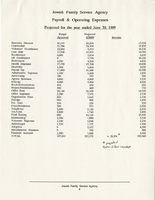Search the Special Collections and Archives Portal
Search Results
Pacific Engineering and Production Company of Nevada (PEPCON) Disaster Collection of News Articles
Identifier
Abstract
The Pacific Engineering and Production Company of Nevada (PEPCON) Disaster Collection of News Articles (1988-1992) consists of articles from Las Vegas and other state and regional newspapers about the PEPCON plant explosion that took place in May of 1988. Also included are United Press International press releases from October to December, 1988.
Archival Collection
Thomas J. Osborne Photograph Collection
Identifier
Abstract
The Thomas J. Osborne Photograph Collection (approximately 1890-1930) consists of black-and-white photographic prints, negatives, and slides. Images depict the family of Thomas J. Osborne, his law office, the family home, and views of the town of Pioche, Nevada and surrounding areas. Several images depict local mines and unidentified mine workers.
Archival Collection
Geneva Stark Merwin Photograph Collection
Identifier
Abstract
The Geneva Stark Merwin Photograph Collection features photographic prints and negatives of locations throughout Pahrump, Nevada between 1941 and 1942. Primary locations include a Pahrump school and Pahrump Ranch, as well as locations in local fields and mountains. The photographs capture candid scenes of people walking to school and feeding animals.
Archival Collection
Ernest Mitchell Pratt Photographs
Identifier
Abstract
The Ernest Mitchell Pratt Photographs (approximately 1932-1936) consist of black-and-white photographic prints, signed and unsigned, taken by Pratt while Hoover Dam was under construction. Many prints are signed and mounted, and two are noted as award-winning photographs shown at the Annual International Salon of Camera Pictorialists in Los Angeles, California. There are additional working prints included alongside the final prints for most of the scenes. Also included in the collection is one small photograph of Pratt. This collection was formerly known as the Price Photograph Collection.
Archival Collection
Paul May Photograph Collection
Identifier
Abstract
The Paul May Photograph Collection (1969) consists of black-and-white and color photographic prints. The images primarily depict Nevada Assemblyman Paul May alongside Nevadan senators and congressmen, including Senator Paul Laxalt. Other images are portraits of May.
Archival Collection
Las Vegas Convention and Visitors Authority Records
Identifier
Abstract
The Las Vegas Convention and Visitor Authority Records (1973-2007) contain memorandums written by Rossi Rallenkotter, the Vice President of the Authority's marketing division to Las Vegas hotel sales and travel directors. The memorandums provide monthly visitor statistics. The collection also includes information on riverboat gambling legislation and the capacities of function/meeting rooms in various Las Vegas hotels. Also included are LVCVA marketing plans and bulletins.
Archival Collection

Orientation manual of the Jewish Family Service Agency of Clark County, 1989
Date
Archival Collection
Description
The orientation manual of the Jewish Family Service Agency provides guidance for the duties of the board of directors, the operation of the agency, the organization chart, and staff listing. It also outlines the role of volunteers in the agency.
Text
Larry Ruvo oral history interview
Identifier
Abstract
Oral history interview with Larry Ruvo conducted by David G. Schwartz on January 27, 2009 for the Remembering Jay Sarno Oral History Project. Ruvo begins by discussing his position as a front desk clerk at Caesar’s Palace in Las Vegas, Nevada in the 1970s. Ruvo then describes how Jay Sarno changed the casino industry by designing Caesar’s Palace with a single theme. Ruvo then chronicles how gaming gradually was legalized in more areas throughout the world and how Sarno capitalized on making Caesar’s Palace an iconic casino which made people want to travel to Las Vegas. Lastly, Ruvo discusses Sarno’s focus on offering both gaming and entertainment options for guests at Caesar's Palace.
Archival Collection
Celesta Lowe oral history interview
Identifier
Abstract
Oral history interview with Celesta Lowe conducted by Patrick Carlton on February 6, 2002 for the Las Vegas Rotary Club Oral History Project. Lowe begins by discussing her early life in Baker, California and her father’s role as a station agent for the Tonopah Tidewater Railroad during the 1920s and 1930s. Lowe then describes her family moving to Las Vegas, Nevada in the 1940s. Lowe chronicles the process state legislatures took to open Nevada Southern University in 1957 and her role as an administrative assistant in the main office of the school. Lowe recounts her career at Nevada Southern University, the expansion of the campus, and renaming it University of Nevada, Las Vegas. Lastly, Lowe talks about her switch from an administrative assistant to a librarian at UNLV.
Archival Collection

Interview with Laurie Joe (L. Joe) Deal, September 27, 2005
Date
Archival Collection
Description
Text
